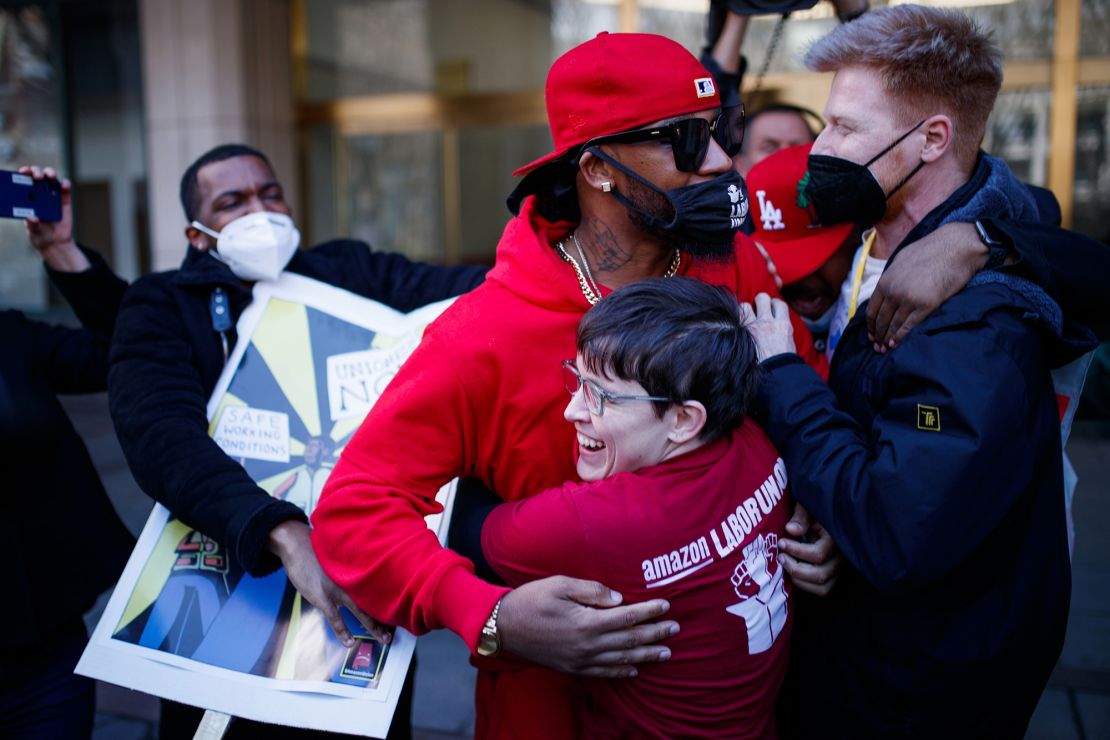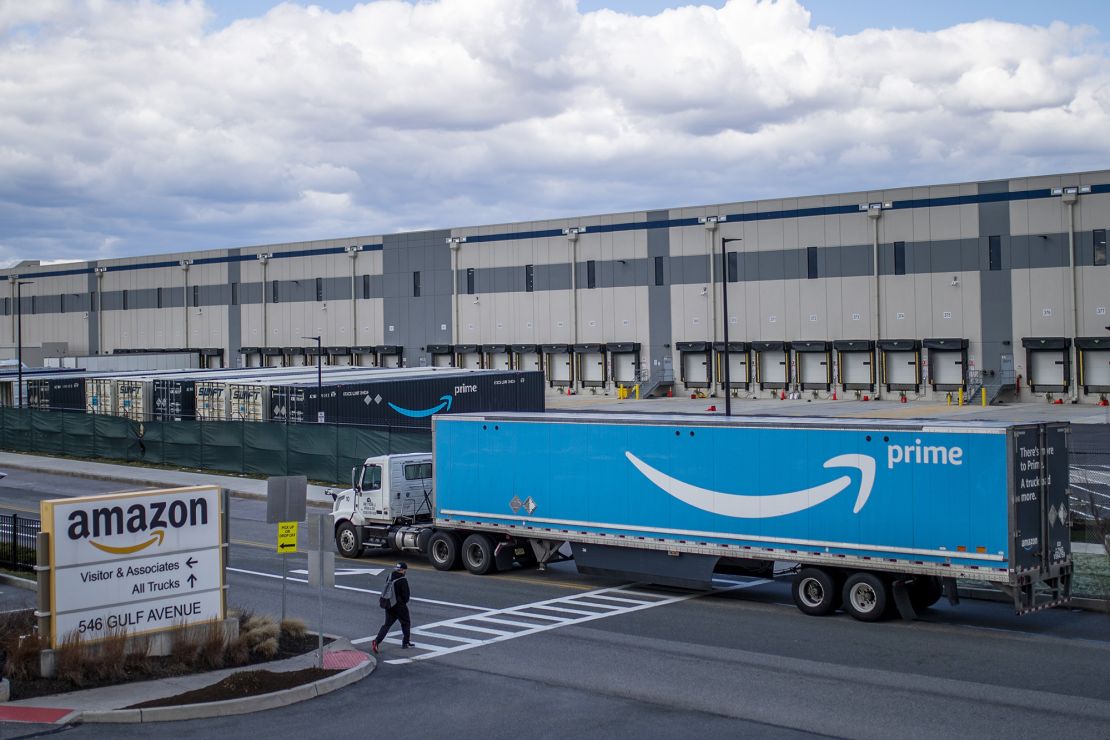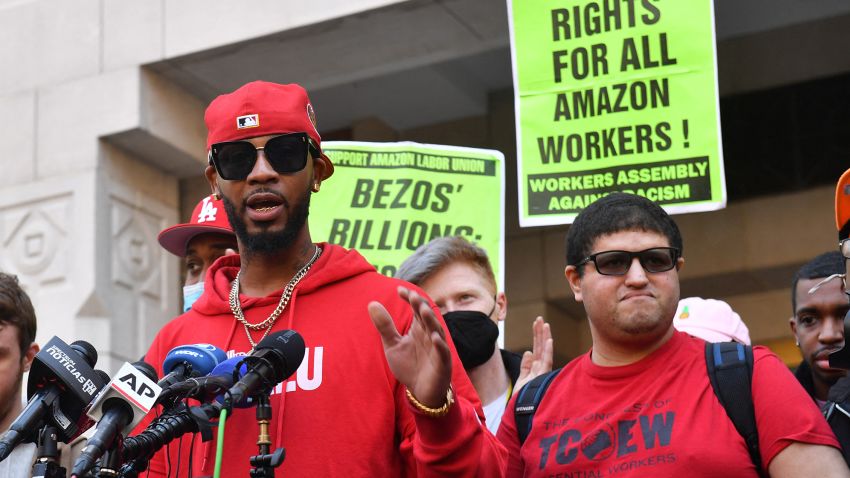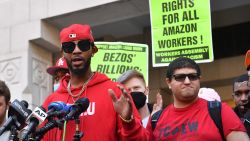After Christian Smalls was fired two years ago from an Amazon warehouse in New York City following his participation in a walkout over its pandemic response, an executive at the company suggested undercutting his organizing efforts by painting him as “not smart, or articulate.” When Smalls’ newly-established organization garnered enough interest to hold a union election at that facility this year, a spokesperson for the tech giant initially cast doubt on the legitimacy of the signatures indicating support. And when the election went forward, Amazon engaged in a full-blown campaign to combat the union drive, including text messages, signage and required group meetings to convey its anti-union message to workers.
But on Friday, the results of that election showed that employees at the Staten Island, New York, facility voted overwhelmingly in favor of unionizing with Amazon Labor Union (ALU), the grassroots labor organization started by Smalls and other current and former Amazon employees of the facility. The move marks the first time a group of US workers have successfully voted to form a union in Amazon’s 27-year history.
The win is striking for a number of reasons, including that ALU is a scrappy effort unaligned with an established labor union. It scored a decisive victory while a drive done in tandem with an 85-year-old labor union in Alabama has stumbled. (The results of an election at Bessemer one year ago favored Amazon but were scrapped after a National Labor Relations Board regional director determined Amazon had illegally interfered, a decision the company called “disappointing.” A do-over election currently remains too close to call.)
Now, the milestone vote and the bootstrapped approach to achieve it may well have ripple effects throughout Amazon, where other union efforts are already underway. It has the potential to motivate workers at other warehouses to unionize, labor experts say, and perhaps to rethink more conventional tactics for doing so. It could also supercharge the broader labor movement in the United States.
Amazon, the country’s second largest private employer, became even more dominant during the pandemic, hiring hundreds of thousands of workers to keep up with surging demand for online deliveries. The company is also widely viewed as setting the standards for what the future of work looks like across the United States, with its emphasis on ultra-efficient warehouses, automation and careful tracking of worker productivity.
“Amazon workers around the country will now have a belief that it’s possible to organize and win an election – but it will still be difficult,” said Rebecca Givan, a labor law professor at Rutgers University. “The odds are always, always stacked against workers organizing in a situation like this, but this is proof that it can be done and it will likely inspire workers elsewhere.”

But as the dust settles on the vote, questions remain about how much Amazon may push back at the new union – and any other efforts that attempt to follow in its footsteps.
How Amazon may push back
Amazon has previously said in statements that its “employees have always had the choice of whether or not to join a union,” while spending $4.3 million just last year on anti-union consultants. In a statement Friday, the company indicated it will explore its options to challenge the results rather than accepting that workers had voted in favor of the effort. (Both parties have until this Friday to file any objections.)
Amazon said it was exploring “filing objections” over what it claims was “inappropriate and undue influence” on the part of the NLRB, the independent federal agency tasked with protecting employees’ right to organize.
Kayla Blado, acting director and press secretary for the NLRB, issued a sharp statement to CNN Business in response to Amazon on Friday. “The NLRB is an independent federal agency that Congress has charged with enforcing the National Labor Relations Act. All NLRB enforcement actions against Amazon have been consistent with that Congressional mandate.”
Givan said Amazon’s statement suggests it may not have a clear path to challenging the results through what might be considered a more typical means. “There don’t seem to be challenges based on conduct of the organizers in the campaign or they would’ve come to light by now, and certainly not on the eligibility of the voters or there would’ve been more challenged ballots,” Givan said.
Similarly, Kate Andrias, a labor law professor at Columbia Law School, called it a “very unusual argument,” noting that it appears the company is “hoping to put political pressure on the NLRB in order to have it stand down.”
What’s clear, according to labor experts, is that Amazon isn’t likely to embrace the ALU, which has another election slated to kick off at a sorting facility in Staten Island later this month. And that could prove challenging when the ALU enters a next phase of negotiating a contract.

Givan said that some employers at times attempt to undermine union efforts by making it difficult to achieve a contract, with a process called surface bargaining.
“They’ll try to do the minimum or won’t be serious at the bargaining table. They have a legal obligation to supposedly bargain in good faith, but there’s not many teeth behind [enforcement of that obligation],” Givan said.
While Amazon is legally obligated to begin bargaining in a timely manner, some labor experts noted Amazon may attempt to delay as much as possible and push off negotiations until any possible legal complaints are resolved. According to John Logan, a professor of labor and employment studies at San Francisco State University, some corporations are of the mindset that “you haven’t lost until you sign a contract.”
Given its significance, Amazon is likely to face a great deal scrutiny in how it navigates the coming weeks and months in response to the results of the election.
Where the union push goes next
Within hours of the union victory, the outcome was praised by the White House, advocacy groups and large labor unions, some of which hinted at plans to build on the new momentum to unionize Amazon.
“The Teamsters are excited to continue this fight against Amazon—on the shop floor, at the bargaining table, and on the streets,” said Sean O’Brien, the newly installed general president of the International Brotherhood of Teamsters, in a statement Friday. The Teamsters, which represents some 1.3 million members including UPS workers, voted last year in favor of making Amazon a key priority and helping its workers achieve a union contract.
Liz Shuler, president of American Federation of Labor and Congress of Industrial Organizations, who previously said the organization would help the Teamsters take on Amazon, also praised the Staten Island result. “In the face of one of the richest, most anti-union corporations, today’s victory proves when working people unite in the fight for justice, anything is possible,” Shuler tweeted.
But the Staten Island effort also underscores that an “unconventional” campaign can be victorious, said Logan. As he put it to CNN Business before the votes were tallied, unionizing Amazon will require “something that’s going to take off like wildfire and, to a large extent, going to be worker-led and based on the self-organization of workers.”
ALU, which bootstrapped its union drive largely through donations raised on the crowdfunding website GoFundMe, may inspire precisely that.
Even before the vote, there were signs of labor organizing ramping up in various corners of Amazon’s vast empire. Those included walkouts over wages and workplace conditions at delivery stations in Chicago, an organizing effort underway at an Amazon Fresh store in Seattle and the other ALU-led union election at a Staten Island sorting facility.
At Smalls’ former warehouse on Staten Island, the focus now shifts from the ballot box to the negotiation table. In a press release Saturday, ALU said Smalls has demanded Amazon begin negotiations in early May. “It is our sincere hope that we can begin a constructive dialogue with our employer, and that the process will result in greatly improved working conditions for Amazon workers,” the release said.
In an interview with CNN Business ahead of the election, Smalls ticked off a list of demands the ALU intends to seek from Amazon, including higher wages, job security, better working conditions, longer breaks, making warehouse workers shareholders again, and securing funds to cover the cost of transportation to and from the facility.
“I would never agree to anything that doesn’t benefit us, and I’m talking about us at the bottom, the entry level workers,” said Smalls. “We’re at least a year or more away from even thinking about dues. We have to fight for a contract first.”






















